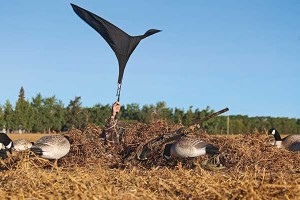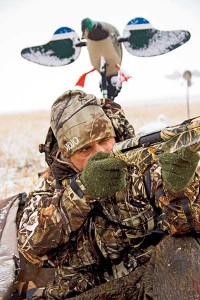November 26, 2013
By P.J. Reilly
 For eons, waterfowlers have been looking for a silver bullet. That one trick guaranteed to convince ducks and geese to drop their feet and head for the decoys. Dead calm sets flare birds. Our Experts talk flagging and spinners.
For eons, waterfowlers have been looking for a silver bullet. That one trick guaranteed to convince ducks and geese to drop their feet and head for the decoys. Dead calm sets flare birds. Our Experts talk flagging and spinners.
So far, adding motion to the rig is probably as close as we've come to finding waterfowl kryptonite. Wave a flag, switch on a spinner or start up a snow-goose tornado, and otherwise wary birds will fold. Motion isn't guaranteed to seal the deal. But when used the right way and at the right time, the power of motion is magical.
Movement catches the eye, it's that simple. Waterfowlers looking to take advantage of that, says Mojo CEO Terry Denmon, need to think of motion in two ways. There's attractant motion and simple motion, he says. Attractant motion is used to get the attention of distant birds, while simple motion fools them into thinking the decoys they're about to join are alive.
When it comes to ducks, the spinning-wing decoy is the gold standard for reaching out to a flock and saying, "Hey! Over here!" The flash they create, which mimics the wingbeats of a duck backpedaling on final approach, is visible from a long way, and gives flocks in the air something to key in on. Every Denmon duck rig — on land and water — has multiple Mojos.
Advertisement
"We had a crop duster tell us he could see one of our Mojos 8.5 miles away," Denmon said. "Now that's the human eye. We don't know how far away ducks can see that motion, but it's probably a couple miles. So you're influencing ducks that might never have even come close to you."
Since ducks are going to key in on the spinners, plant them close to your hunters, within shotgun range.
Gander Flaps
Advertisement
Dark-goose hunters do things a little differently. They've been waving black flags at flocks for decades. It's a simple trick that's also intended to mimic flapping wings. Companies tried making spinners for honkers and specks, but it turns out they don't like that kind of motion, even when it's a duck.
 On our annual Ontario hunt, where we expect ducks early, followed by Canadas, we set mixed rigs of both types of decoys, including a couple of spinning-wings. As soon as we think the duck flight is finished, and the honkers start rolling, we turn off the spinners. They've spooked plenty of geese, so we know not to leave them on.
On our annual Ontario hunt, where we expect ducks early, followed by Canadas, we set mixed rigs of both types of decoys, including a couple of spinning-wings. As soon as we think the duck flight is finished, and the honkers start rolling, we turn off the spinners. They've spooked plenty of geese, so we know not to leave them on.
When honkers and specks are way off, go crazy with a flag, says Fred Zink, owner of Zink Calls and Avian-X Decoys.
"Run around in the decoys with that thing over your head, wave it back and forth in big strokes — whatever you can get away with to get their attention," he said.
Light-goose hunters have the advantage of deploying white decoys, which are eye-catching in their own right. Setting a big rig of white is how they attract passing flocks. But they can enhance that drawing power with tornado machines. These contraptions whirl two or four flexible rods with flapper decoys attached to the ends, making it look like you've got a couple snows perpetually buzzing your spread.
Avery Outdoors pro-staffer Kevin Addy mainly likes using tornado machines when there's little or no wind. In a stiff breeze, Addy's sock decoys, which comprise the bulk of his spread, dance and waddle, while his pole-mounted fliers bob up and down, giving him all the motion he needs. But when the wind is calm, his socks and fliers go limp.
"With snows, a big rig will draw them in, but if they don't see some motion, it's not unusual for them to hit a certain point and then bail," Addy said. "It's really frustrating, but you'll know the problem because all the flocks will bail at around the same distance."
Rotary machines for light geese work best when they're planted upwind of the hunters. As birds glide toward the flying dekes, they should pass right in front of your shotgun barrels.
Fool'em Close
Once you get the attention of a bunch of ducks or geese with attractant motion, you can then seduce them into shotgun range with simple motion.
"You want to give them something to focus on in the rig," said Tim Noe of Lucky Duck. "That's going to serve two purposes. It's going to keep them from possibly spotting you, and it's going to fool them into thinking your decoys are alive."
Waterfowlers and equipment manufacturers have gotten incredibly creative over the years in finding ways to put simple motion into a spread. Take the jerk cord. That's a tool that definitely was invented by a hunter looking to give his decoys some life. Run a couple floaters off an elastic cord, stretch a length of line to the blind that you can tug when birds are in close, and you can get those decoys to swim on command.
 "I still use jerk cords," Denmon said. "They work."
"I still use jerk cords," Denmon said. "They work."
Water hunters do have some feasible battery-powered options for creating simple movement. Mojo's Flyway Feeder is the back end of a duck fitted with a water pump. The pump moves water so the butt wiggles and shakes — like the butt of a real duck snacking on submerged vegetation. Lucky Duck's Quiver Magnet H2O is a vibrating disc you can toss out with your decoys to generate surface disturbance.
"When the water is calm, decoy spreads just don't look natural," Noe said. "You never see live ducks in water without some rippling."
Out in the fields, spinning-wing decoys can do the trick. But their widespread use might hamper the ability to finish birds — especially in late season.
"We'll see ducks shy away from them in the late season after they've spent the last couple of months flying all the way down from Canada seeing spinning wings just about every day," Denmon said.
Enter a simple motion decoy like Lucky Duck's Rapid Flyer. It has photo-printed wings that flap up and down, rather than spin. "It's something ducks aren't necessarily used to seeing in decoy spreads," Noe said. "And it's subtle movement. That's why it works."
Besides the Rapid Flyer, Lucky Duck also makes a whole line of spinning-wing decoys. Noe sets both kinds of motion dekes in his rig. When the birds are far off, he'll run the spinners. But, if the birds get spooked by the spinners, he'll shut them off remotely once the ducks are locked on his rig. "From there, I let the Rapid Flyers do their thing," he said.
Cool Breeze
Remember the "simple" in simple motion when it comes to Canada geese, Zink says.
"They don't like the flash and the real erratic movements that work for ducks and snow geese," he said. "Canada geese just want to see some gentle waddling or very light flagging."
Zink counts on the wind for the bulk of his ground-level decoy motion. He likes all his decoys to sit on motion stakes so they can waddle in the breeze.
"Geese move when they're feeding," Zink said. "It's natural and it makes incoming flocks feel comfortable. The problem with decoys that don't move is they put flocks on alert. The only time real geese on the ground freeze is when they sense danger.
"If the geese coming in don't see any ground movement, they're going to think there's danger."
Zink's Avian-X honker decoys are designed to provide subtle ground movement in the wind.
"In a pretty good wind, some decoys just move too much," he said. "Canada geese don't like that. You don't see real Canadas doing anything crazy when they're feeding."
 If you have a decoy that's spinning or shaking erratically, shove its stake deeper into the ground, Zink recommends. It's OK to flag for simple motion, he said. Pass out a couple among the guys in the party. Just be aware simple-motion flagging is nothing like attractant flagging.
If you have a decoy that's spinning or shaking erratically, shove its stake deeper into the ground, Zink recommends. It's OK to flag for simple motion, he said. Pass out a couple among the guys in the party. Just be aware simple-motion flagging is nothing like attractant flagging.
"When geese get inside 300 yards, I don't like anybody lifting a flag higher than the backs of any of my decoys," he said. "I want the birds to see the movement, but I don't want them to know what it is, or be able to see it's a flag. Educated geese have all seen flags. They'll pick them out if you show them too much."
Motion in your rig is killer. But it's kind of like pork rinds. At some point, they're going to give you heartburn. "Reading the birds is critical when it comes to motion," Addy said. "If they're flaring at your motion decoys, you have to react to that. I'll take my tornado machines out of the rig and put them in the trailer in a heartbeat if they're spooking the birds."
Seems pretty obvious, but Addy has seen plenty of stubborn hunters who put so much faith in their motion decoys that they run them no matter what.
"In waterfowl hunting, you shouldn't be so attached to anything that you'll use it every time," Noe said.

